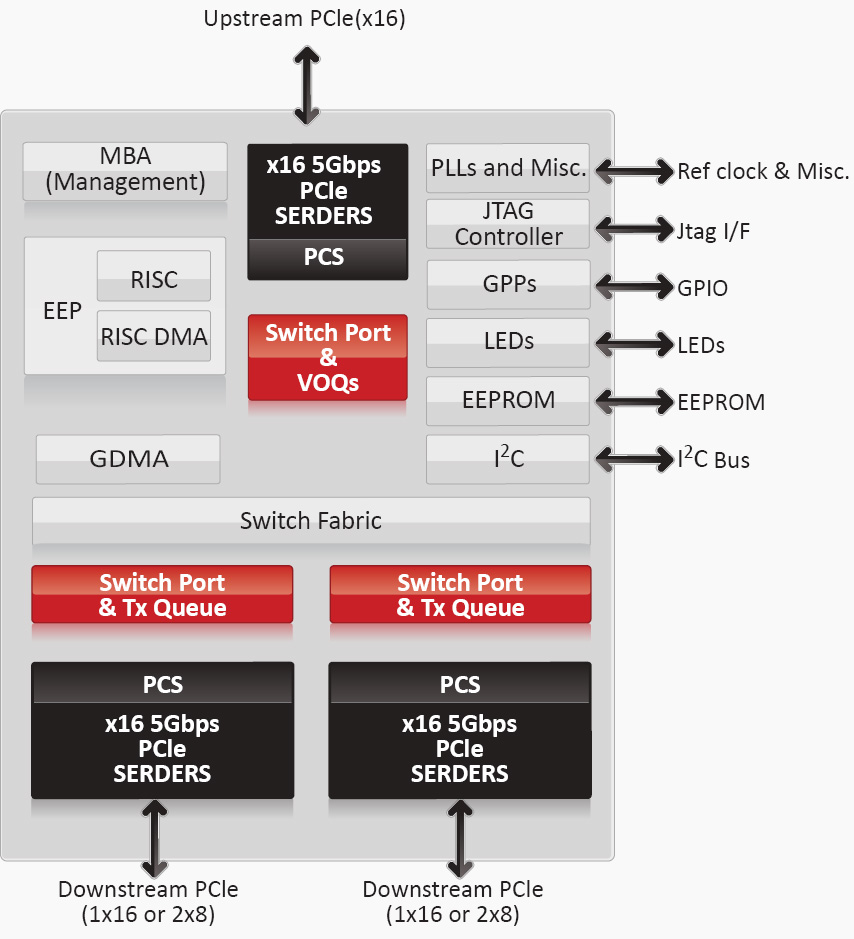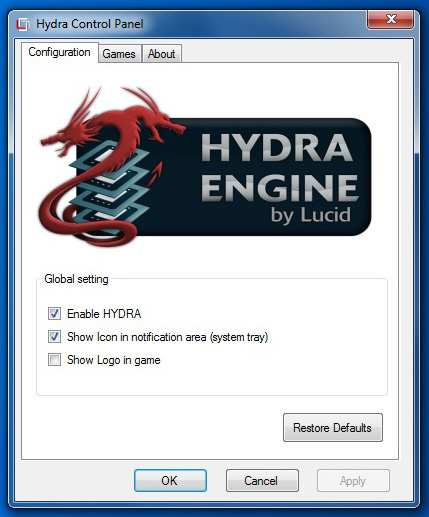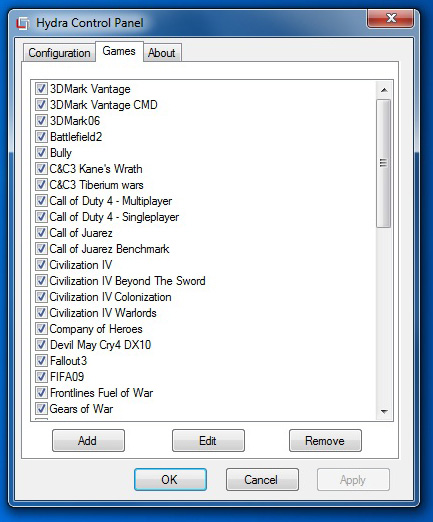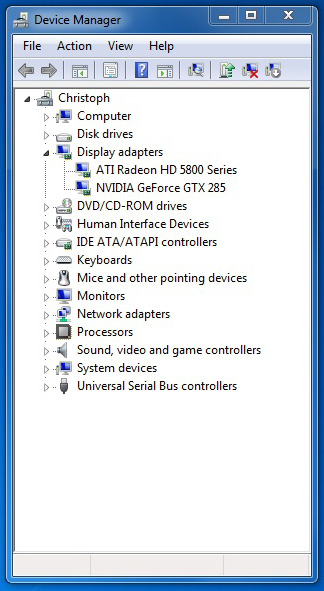MSI Big Bang Fuzion: Pulling The Covers Off Of Lucid’s Hydra Tech
Hydra 200: An Evolved ASIC
When Lucid first began showing off what it was working on, the company was using Hydra 100-series hardware—manufactured on a 130nm process, limited to PCI Express 1.1 signaling rates, and rated for 3.5W power consumption.
The LT24102—Lucid’s highest-end ASIC (in a family of three Hydra 200-series SoCs)—is a second-gen part compatible with PCI Express 2.0, manufactured at 65nm, and rated for up to 5.5W. The ASIC’s 48 PCIe lanes allow it one x16 upstream port and two x16 downstream ports, one x16 and two x8s, or a quartet of x8 connections. An embedded 300 MHz RISC processor with 64KB instruction cache and 32KB data cache exercises control over the device’s switch port.
Hardware, Meet Software
Before you’re able to utilize the Hydra engine you have to install Lucid’s driver software, which is currently evolving in a notable way. It used to be that every time ATI or Nvidia updated their own drivers, Lucid would have to qualify them and iron out any new glitches introduced by either vendor. Clearly, this would have been an ongoing (and compounding) support nightmare for Lucid’s engineers.
But with the company’s most recent driver drop, version 1.4, a reshuffling of where the Hydra engine exists in software means it’s no longer necessary to sweat the Catalyst or GeForce version you’re using.
That’s not to say the game, API, and operating system compatibility stories have simplified at all:
- You’re still limited to DirectX 9 and DirectX 10.
- You’re still limited to Windows Vista (32- and 64-bit) and Windows 7 (32- and 64-bit). Moreover, X-mode—running an ATI and Nvidia card in the same machine, is limited to Windows 7, which gives you the ability to install multiple graphics drivers concurrently.
- You’re still subject to Lucid’s own game testing. According to the company, many titles work right out of the box. Others require specific optimization in its driver. This is perhaps the biggest challenge facing Lucid in making Hydra a transparent technology for gamers to enjoy. Not only do the hardware vendors have to work out the kinks when a new title is launched, but then Lucid has to do the same thing.
Depending on the graphics card configuration you’re running, there are different lists of games qualified to pass QA. For example, in driver 1.4.1, Lucid presents a list of 42 different games validated on all five of its available hardware combinations. An additional 22 are supported by N- and A-modes (not X-). Nine others work in N-mode, and five work in A-mode. One of the things we’ll be testing today is Hydra’s compatibility. We’ve recently upgraded our benchmark suite with newer games, so it’ll be a challenge for Lucid, to be sure.
Get Tom's Hardware's best news and in-depth reviews, straight to your inbox.
What if your favorite new game isn’t one of the ones qualified to run acceptably? Does that mean you’re out of luck? Not necessarily. You can manually add the game to the driver control panel, which will turn Hydra on for that title. Here’s the breakdown:
- If Hydra is disabled on the Fuzion board (through the control panel or system tray icon), any game you play will run on a single GPU.
- If Hydra is enabled and the game is not on the control panel’s list of validated/manually-added titles, it’ll run on a single GPU.
- If Hydra is enabled and the game is on the list, it’ll run on multiple GPUs and (hopefully) realize a speed-up. If you added the game manually, it could encounter problems given that it wasn’t validated.
The X-Factor
Perhaps Hydra’s sexiest selling point is the ability to augment your once-fastest Nvidia-based graphics card with something faster from ATI. Sure beats hawking that $500 GeForce GTX 285 on Ebay for $250 used, right? Well, there are a few things you’ll need to keep in mind before assuming Radeons and GeForces get along.
Most important, the obvious: you’re using dissimilar architectures from competitors who use differentiation to sell more GPUs. Mixing them will get you a lowest common denominator. Lucid seems rife with smart engineers, but they’re not magicians. They can’t make a Radeon HD 5870 accelerate PhysX or a GeForce GTX 260 support DirectX 11. Instead, you have to give up both. You’ll see in the benchmarks that we weren’t able to achieve PhysX acceleration as long as there was an ATI card installed, and we weren’t able to run the latest S.T.A.L.K.E.R.: Call of Pripyat test with DX11 lighting with an Nvidia board present.
There’s another caveat here that might temper your enthusiasm a bit: Lucid recommends mixing non-identical cards with performance profiles as close as possible in order to maximize scaling. Match too-fast of a board with something too slow and you’ll see minimal gain, if any. That might be a tough pill to swallow for upgraders who aren’t necessarily looking to jump sideways from a GeForce GTX 260 to, say, a Radeon HD 4890.
Current page: Hydra 200: An Evolved ASIC
Prev Page The Many Heads Of Hydra Next Page Test Setup And Benchmarks-
Maziar Nice article,its very good for users for upgrading,because for current SLI/CF you need 2 exact cards but with Lucid you can use different cards as well,but it still needs to be more optimized and has a long way ahead of it,it looks very promising thoughReply -
Von_Matrices I'm highly doubtful of the Steam hardware survey. I think it is underestimating the number of multi-GPU systems. I for one am running 4850 crossfire and steam has never detected a multi-GPU system when I was asked for the hardware survey. The 90% NVIDIA SLI seems also seems a little too high to me.Reply -
Bluescreendeath The CPU scores for the 3D vantage tests are way off. You need to turn off PhysX when benchmarking the CPU or it will skewer the results...Reply -
Bluescreendeath So far, the best scaling has been in Crysis. The 5870/GTX285 combo benchmarks looked very promising.Reply -
cangelini BluescreendeathThe CPU scores for the 3D vantage tests are way off. You need to turn off PhysX when benchmarking the CPU or it will skewer the results...Reply
It's explained in the analysis ;-) -
kravmaga "But when you spend $350 on a motherboard, you’re using graphics cards that cost more than that. If you’re not, you aren’t doing it right"Reply
Quoted from the last page; I disagree with that statement.
There are plenty of people in situations where using this board is a better investment performance per dollars. This is all the more relevant as this technology will undoubtedly find its way into cheaper boards and budget oriented setups where it will make all the sense in the world to bench it using mid-end value parts.
I, for one, would have liked to see what using gtx260s and 5770s would look like in this same setup. As is, this review leaves many questions unanswered. -
SpadeM Well the review does give an answer in the form of: It's better to run a ATI card for rendering and a nvidia card for physics and cuda (if u're into transcoding/accelerating with coreavc etc.) with windows 7 installed.Reply
Or at least that is the conclusion i'm comfortable with at the moment. -
HalfHuman i also agree with the fact that a person who will buy this board will necessarily go for the highest priced vid boards. maybe some will but not all. there will be more who will try to save the older vid cards.Reply
i also understand why you paired the 5870 with nvidia's greatest. there is a catch however... lucid guys did not have the chance to play with 5xxx series too much and you may be evaluating something that is not too ripe. i guess the 4xxx series would have been a better chance to see how well the technology works. couple that with games that are not yet certified for lucid, couple that with how much complexity this technology has to overcome... i think this is a magnificent accomplishment o lucid team part.
i also think that in order for this technology to become viable it will go down in price and will be found in much cheaper boards. for the moment the "experimenting phase" is done on the expensive spectrum. i saw some early comparisons and the scaling was beautiful. i know that the system put together by lucid... but that is fine since that was only a demo to show that it works. judging on how fast this guys are evolving i guess that they will go mainstream this year.




